Common menu bar links
Breadcrumb Trail
ARCHIVED - Public Health Agency of Canada - Report
 This page has been archived.
This page has been archived.
Archived Content
Information identified as archived on the Web is for reference, research or recordkeeping purposes. It has not been altered or updated after the date of archiving. Web pages that are archived on the Web are not subject to the Government of Canada Web Standards. As per the Communications Policy of the Government of Canada, you can request alternate formats on the "Contact Us" page.
Section II – Analysis of Program Activities by Strategic Outcome
Strategic Outcome
The Agency's Strategic Outcome is: Canada is able to promote health, reduce health inequalities, and prevent and mitigate disease and injury. The following section describes the six Program Activities (PAs) through which the Agency works to achieve the Strategic Outcome, and for each, identifies the expected results, performance indicators and targets. This section also explains how the Agency plans to achieve the expected results and presents the financial and human resources that will be dedicated to each Program Activity.
Program Activity 1.1 – Science and Technology for Public Health
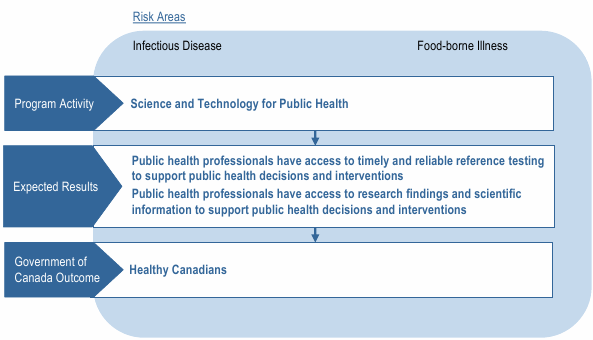
[enlarge]
Program Activity Description
To enable Canada to improve public health and better respond to existing and emerging health risks, this program: develops and applies leading edge national public health science and innovative tools; provides specialized diagnostic laboratory testing and reference services; conducts applied and discovery research into established, emerging, and rare infectious diseases; and mobilizes Canadian scientific capacity and networks. The program's primary clients are public health professionals working in federal, provincial, territorial, municipal/ local and non-government organizations. By integrating reliable information and knowledge, this program supports public health decision-making and interventions in Canada.
Human Resource (FTEs) and Planned Spending ($ M)
| 2012–13 | 2013–14 | 2014–15 | |||
|---|---|---|---|---|---|
| FTEs | Planned Spending |
FTEs | Planned Spending |
FTEs | Planned Spending |
| 385 | 65.4 | 385 | 59.4 | 386 | 58.0 |
The completion of construction of the JC Wilt Infectious Disease Research Centre in Winnipeg is the main reason for the decrease of $6M from 2012–13 to 2013–14. The Genomic Research and Development Initiative ends in 2013–14 which explains the decrease of $1.4M from 2013–14 to 2014–15.
| Expected Result(s) | Performance Indicator(s) | Target(s) |
|---|---|---|
| Public health professionals have access to timely and reliable reference testing to support public health decisions and interventions* | % of accredited reference service tests within the various specific turnaround times (TAT) | 80% |
| % of reference service programs subject to external review achieving a ranking of "acceptable" or better | 100% | |
| Public health professionals have access to research findings and scientific information to support public health decisions and interventions | # of citations of research publications during the target year (e.g. 2012) for papers published during the preceding three years (e.g. 2010-2012)** | 1500 |
* Reference testing performed by Agency laboratories includes specialized diagnostic testing, confirmatory testing and special testing to characterize disease-causing agents. Such reference testing is carried out both routinely and in response to emergency outbreaks.
** This may not include all PHAC publications.
Planning Highlights
As a science-based organization, PHAC strives to ensure that its leading edge public health research, science, and innovation tools respond to Canadians' expectations for timely and reliable public health advice and interventions. Moreover, Canadians can be assured that their personal health decisions are based on advanced scientific knowledge. The following major activities are planned:
- Improve the technical capacity of Federal, Provincial and Territorial (F/P/T) PulseNet Canada Network partners to utilize "DNA fingerprinting" in the identification and response to multi-jurisdictional food-borne illness outbreaks.
- Strengthen scientific and technical expertise and foster cross-jurisdictional cooperation to improve evidence and information availability for public health practitioners, policy-makers and Canadians and ensure timely outbreak detection and response to infectious disease threats.
- Through innovative research, tools and laboratory reference services, improve knowledge regarding the link between genetic predisposition and the risks of chronic and infectious disease in key populations in Canada and better enable public health professionals to respond to and address emerging public health risks.
- In conjunction with federal partners, explore collaborative opportunities in laboratory infrastructure and operations as well as realize programmatic synergies to maximize overall laboratory efficiencies.
Program Activity 1.2 – Surveillance and Population Health Assessment
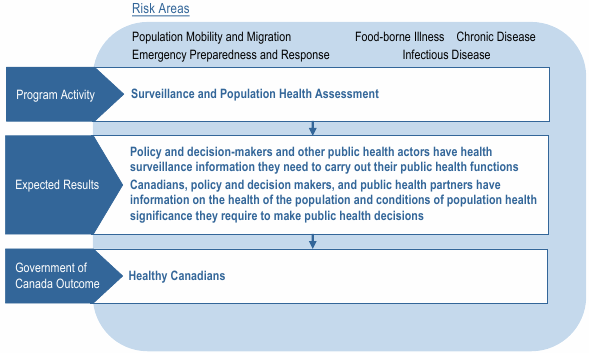
[enlarge]
Program Activity Description
Emerging and ongoing infectious and chronic diseases and other population health risk factors, have an impact on the health of Canadians. The Surveillance and Population Health Assessment program exists to identify and report on health issues and risks through ongoing, systematic analysis, use and sharing of routinely-collected data with and among provinces, territories, and local health authorities, and other federal departments and agencies so that they can make informed decisions. In doing so, the program addresses existing gaps and emerging trends in the ways that public health surveillance and population health assessment are conducted. A national approach to surveillance and population health assessment provides the foundation for coordinated efforts in health promotion, health inequality reduction and disease mitigation and control.
Human Resource (FTEs) and Planned Spending ($ M)
| 2012–13 | 2013–14 | 2014–15 | |||
|---|---|---|---|---|---|
| FTEs | Planned Spending |
FTEs | Planned Spending |
FTEs | Planned Spending |
| 420 | 64.6 | 420 | 64.6 | 421 | 64.0 |
| Expected Result(s) | Performance Indicator(s) | Target(s) |
|---|---|---|
| Policy and decision-makers and other public health actors have health surveillance information they need to carry out their public health functions | % compliance by Canada on the surveillance component of the International Health Regulations on Core Capacity Assessment | 100% by March 31, 2014 |
| Canadians, policy- and decision-makers, and public health partners have information on the health of the population and conditions of population health significance they require to make public health decisions | Level of stakeholder satisfaction with the usefulness of the information in the CPHO Report | "Very useful" by March 31, 2016* |
*CPHO Report Post Release survey responders from among public health stakeholders chose "very useful" on the 5-point scale from "not at all useful" to "very useful."
Planning Highlights
PHAC's surveillance and population health assessment initiatives are integral to the timely and accurate collection and sharing of information that is absolutely essential for prompt and effective emergency response as well as informed decisions and public health policy. The following major activities are planned:
- Strengthen surveillance through the implementation of the Agency's Surveillance Strategic Plan and continue to address recommendations from the May 2008 Report of the Auditor General. This will be achieved by maintaining a structure and processes to identify and address surveillance-related system priorities; working with partners to identify roles and responsibilities in collaborative surveillance activities; implementing and maintaining mechanisms and tools for effective partnerships and managing data and information; and, the development and use of standardized tools for the implementation of ongoing performance assessment of surveillance (i.e., Surveillance Performance Measurement Framework). An evaluation of the surveillance function at the Agency is planned for this fiscal year, with the first phase addressing relevance. It is expected to be completed by March 2013.
- Increase capability in assessing the health of the population through developing different approaches to population health analyses (e.g. Emerging Global Realities Scenario Project) and perspectives for program and policy development (i.e. systems approach to public health).
- Strengthen the evidence base of surveillance on childhood obesity and neurological diseases and enhance mental illness surveillance to provide stakeholders with improved information on risk factors contributing to these conditions.
- Further develop and communicate the first national Indicator Framework for Chronic Disease and Associated Determinants, which will consider the interaction between determinants of health, risk factors, and health outcomes across the life-course. This will support program and policy decisions makers in addressing the multiple facets of chronic disease.
- Enhance collection and analysis of surveillance data on congenital anomalies and develop a surveillance system for Developmental Disorders as part of the Action Plan to Protect Human Health from Environmental Contaminants. The initial focus is Autism Spectrum Disorders.
- In partnership with Health Canada, expand data collection, analysis and reporting on the rates, patterns and circumstances of unintentional injury related to consumer products to build the evidence base for policies, practices and programs that target vulnerable populations such as children and seniors.
- Improve the evidence and available information to public health practitioners, policy-makers and Canadians by developing methodologies for enhanced and integrated zoonotic and vector-borne disease surveillance as well as a process for prioritization of emerging infectious disease risks and joint risk assessments with the Canadian Food Inspection Agency.
- Develop and begin the implementation of a federal strategy to enhance, integrate and coordinate the surveillance of antimicrobial use (AMU) and resistance (AMR) in food animals, food products and humans, including AMR laboratory diagnostics. Increase information available to public health practitioners to inform decisions taken to minimize the emergence and spread of AMR in Canada.
- Improve coordination of surveillance data related to selected infections (HIV, syphilis and tuberculosis) within Canada and improve our understanding of infection patterns and public health approaches specific to immigrant populations.
Program Activity 1.3 – Public Health Preparedness and Capacity
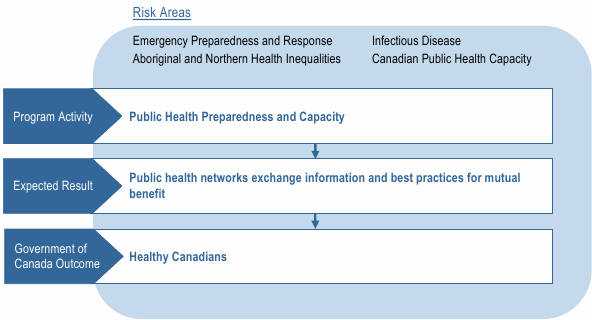
[enlarge]
Program Activity Description
The Public Health Preparedness and Capacity Program addresses the need for a strong public health system that is prepared at all times for strategic and operational public health issues and events. This program provides public health decision-makers with the right people in the right place at the right time equipped with the right competencies, capabilities and connections to carry out public health functions. The program identifies and facilitates the closing of gaps in Canada's public health human resource capacity, the ability to prepare for and respond to public health issues and events and the functioning of public health networks within and outside Canada.
Human Resource (FTEs) and Planned Spending ($ M)
| 2012–13 | 2013–14 | 2014–15 | |||
|---|---|---|---|---|---|
| FTEs | Planned Spending |
FTEs | Planned Spending |
FTEs | Planned Spending |
| 320 | 85.1 | 320 | 71.3 | 321 | 67.0 |
The decreases in planned spending of $13.8M from 2012–13 to 2013–14 and $4.3M from 2013–14 to 2014–15 are mainly due to the scheduled reductions of funding associated with the installation of a vaccine fill line and replenishment of the National Antiviral Stockpile.
| Expected Result(s) | Performance Indicator(s) | Target(s) |
|---|---|---|
| Public Health networks exchange information and best practices for mutual benefit | # of information and best practice exchanges | 3 |
Planning Highlights
Effective coordination and increased capacity among partners are critical to the effective preparation for public health events and in addressing trends in the risk factors leading to diseases. The following major activities are planned:
- Facilitate Canada-wide coverage of public health professionals with the capacity to respond to public health events. This includes placing public health practitioners in northern sites and the recruitment and mobilization of field epidemiologists and public health officers across Canada.
- Address Canada's need for public health skills by continuing to provide a competency-based suite of learning modules on core public health functions to enhance ability to respond to public health issues.
- Improve access to opportunities for public health learning through the Skills Northern Strategy. Disseminate the results of the Skills Northern Strategy pilot and evaluation. Review and update Skills Online learning modules, as appropriate, to reflect the northern and Aboriginal context.
- Continue the development of tools and processes such as the Health Canada/PHAC Research Ethics Board to ensure that research and decision-making processes are well-designed and ethically sound.
- Ensure Health Portfolio emergency management (EM) plans reflect current knowledge and experiences. Lead revisions of EM plans based on lessons learned from planned exercises, real events and mass gatherings under the direction of the Portfolio's Joint Emergency Preparedness Committee.
- Inform strategic emergency management planning across the Health Portfolio with a focus on risk treatment through the review of the first risk assessment process done in 2011–12. Examine variables such as vulnerability, adequacy and effectiveness of controls and risk tolerance to make recommendations regarding improvements to, or implementation of new, risk treatment interventions.
- Health Portfolio professionals and first responders are trained in emergency management and CBRNE (chemical, biological, radiological, nuclear and explosive) response, respectively.
- Undertake a comprehensive review and revision of Canada's Pandemic Influenza Plan for the Health Sector to integrate changes based on stakeholder input to make the CPIP more adaptable and responsive to pandemic threats.
- Improve the evidence and available information to public health practitioners by providing up-to-date public health practice advice through renewed guidelines to the Infection Prevention and Control Guideline Series.
Program Activity 1.4 – Health Promotion
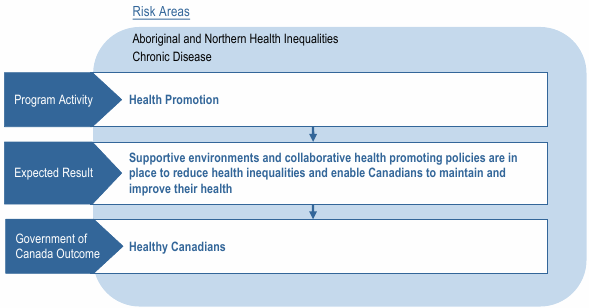
[enlarge]
Program Activity Description
This program provides leadership and support in promoting health and reducing health disparities among Canadians. It supports Canadians in making healthy choices throughout all life stages through initiatives focused on, for example, child development, families, lifestyles, and aging. It also facilitates the conditions that support these choices by working with and through others to address factors and determinants that influence health, such as health literacy, food security, social support networks and the built environment.
Human Resource (FTEs) and Planned Spending ($ M)
| 2012–13 | 2013–14 | 2014–15 | |||
|---|---|---|---|---|---|
| FTEs | Planned Spending |
FTEs | Planned Spending |
FTEs | Planned Spending |
| 374 | 181.4 | 374 | 181.2 | 375 | 181.3 |
| Expected Result(s) | Performance Indicator(s) | Target(s) |
|---|---|---|
| Supportive environments and collaborative health promoting policies are in place to reduce health inequalities and enable Canadians to maintain and improve their health | # of communities reached | 5703 |
| # by type of health promotion initiatives* | 1275 | |
| % of collaborations that result in joint action having an objective of influencing supportive environments and health promoting policies | 80% |
*In this context, initiatives generate and disseminate knowledge products; design and test innovative approaches to address priority public health issues; deliver programming distinct from contribution agreements; and include strategic initiatives such as international conferences.
Planning Highlights
PHAC contributes to the development of healthier Canadians by enabling individuals to improve their health and all levels of government and institutions to better address the factors that influence and determine health and health inequalities. The following major activities are planned:
- Engage key stakeholders to reduce the rates of childhood obesity as guided by Curbing Childhood Obesity: an F/P/T Framework for Action to Promote Healthy Weights. Investments and social marketing will target the relationship among physical activity, healthy eating, and healthy weights and align efforts with other sectors (sports, physical activity, and recreation).
- Contribute to the reduction of health inequalities in vulnerable children (including Aboriginal children in rural, urban and northern settings) and families through the support of collaborative efforts and programs such as the Canada Prenatal Nutrition Program, the Community Action Program for Children and Aboriginal Head Start in Urban and Northern Communities.
- Advance action on the social determinants of health and the reduction of health inequalities to better position decision-makers to influence policy and action for public health, including Aboriginal and northern communities. This is supported by innovation in population health interventions (i.e., by designing, testing and evaluating new policies and initiatives to fill evidence gaps on how to avert and mitigate inequalities among disadvantaged populations) to contribute to better health outcomes for Canadians via the Innovation Strategy.
- Enhance efforts to reduce trauma, disability and premature death associated with seniors' falls and social determinants of seniors' health by advancing knowledge surrounding seniors' falls and equipping Age Friendly Communities with a comprehensive set of indicators to measure how communities are becoming better, healthier and safer places for seniors to live.
- Enhance public health capacity through support and collaboration on research and best practices in promoting mental health and suicide prevention as well as working with others to share public education messages and enhance awareness among Canadians.
- Work with Health Canada and territorial partners to implement the Health Portfolio's Northern Wellness Approach, which is focused on reducing the administrative and reporting burden for regional health promotion and disease prevention in the Territories as well as improving the overall program fit and effectiveness.
Program Activity 1.5 – Disease and Injury Prevention and Mitigation
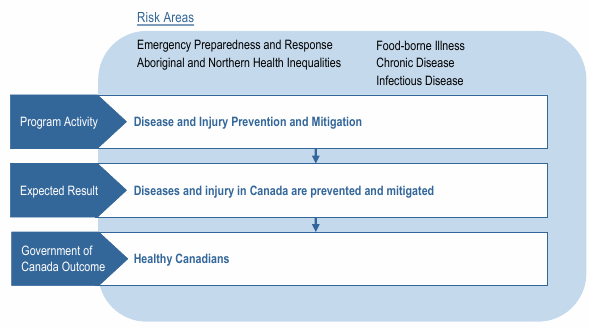
[enlarge]
Program Activity Description
This program contributes to the identification, prevention, mitigation, and reduction of disease and injury in Canada. Through the provision of information and evidence-based knowledge and tools, it enables national and international decision-makers and public health experts to implement policies, programs and interventions aimed at addressing the incidence, prevalence and impact of disease and injury. It leads federal efforts and promotes national and international cooperation, collaboration, and consultations to identify public health measures and reduce public health risk factors associated with disease and injury. This program is necessary because chronic disease, infectious disease, and injury are primary causes of hospitalization, disability, and mortality in Canada.
Human Resource (FTEs) and Planned Spending ($ M)
| 2012–13 | 2013–14 | 2014–15 | |||
|---|---|---|---|---|---|
| FTEs | Planned Spending |
FTEs | Planned Spending |
FTEs | Planned Spending |
| 347 | 100.5 | 347 | 94.8 | 348 | 142.2 |
Planned spending will decrease by $5.7M in 2013–14 from 2012–13 mainly due to the completion of the initiative to address sport and recreation injuries among Canadian children. In 2014–15, an increase of $47.4M is primarily the result of the final payment for the Hepatitis C Health Care Services Program.
| Expected Result(s) | Performance Indicator(s) | Target(s) |
|---|---|---|
| Diseases and injury in Canada are prevented and mitigated | Rate of age-standardized new diagnoses of major diseases (cardiovascular disease, cancer, diabetes, asthma, and chronic obstructive pulmonary disease (COPD)) during a one-year period (incidence) |
Baselines established:*
|
| Unintentional and intentional injury incidence rates over a one-year period |
Baselines identified: All injuries (all ages):
Unintentional Injuries (all ages):
|
|
| Rate of reported cases of infectious diseases including health care associated infections, during a one-year period |
Baselines identified:
Baselines for health care associated infections to be established by March 31, 2013. |
*As a signatory of the Political Declaration adopted at the September 2011 UN High Level Meeting on the Prevention and Control of NonCommunicable Disease, Canada is participating in the development of a global monitoring framework, including indicators and voluntary targets. This process will assist in the identification of non-communicable disease targets for the Agency.
Planning Highlights
Through promoting national and international collaboration and providing up-to-date and relevant information on diseases and injury prevention to public health practitioners, policy makers and individual Canadians, PHAC contributes to the reduction of hospitalisation, disability and mortality associated with chronic disease, infectious disease and injury. The following major activities are planned:
- Help reduce Canadians' risks for and decrease the impact of diseases such as cancer, diabetes, cardiovascular and respiratory diseases by supporting community-based initiatives focused on risk factors (such as unhealthy diets and physical inactivity) common to major chronic diseases.
- Support the implementation of the Political Declaration adopted at the September 2011 UN High Level Meeting on the Prevention and Control of Non-Communicable Diseases by working with the World Health Organization and other countries to develop a global monitoring framework with indicators and recommendations for voluntary global targets which reflect Canada's interests.
- Build pre-diabetes screening capacity with Inuit populations and enhance cancer prevention capacity in the North through collaboration with public health practitioners.
- Help advance the work of the Canadian Task Force on Preventive Health Care to develop clinical practice guidelines that provide evidence and up-to-date information to public health practitioners, policy-makers and individual Canadians on chronic disease prevention issues. Access to this knowledge and tools such as the Chronic Disease Prevention Kit, will help practitioners support their patients in making lifestyle changes to reduce the risk of developing chronic disease.
- Collaborative relationships are established over the next two years in pursuit of reductions in sport and recreation-related injuries for at-risk and underserved children and youth populations (e.g. rural, remote and northern communities).
- In collaboration with stakeholders, refine the National Immunization Strategy with more efficient vaccine recommendation processes, vaccine program development, and immunization programs. Determine the level of vaccine uptake/coverage in the Canadian population.
- Adopt science-based One Health practices to improve the understanding of food-borne illness and zoonoses, and guide upstream solutions (or approaches) to food-borne, zoonotic, and environmental issues via collaborative activities.
- To contribute to the prevention and control of communicable disease among First Nations and Inuit Peoples, strengthen partnerships with Health Canada and other Government of Canada departments to increase coordination, integration and coherence of programs and services.
- Expand the information and knowledge base available to public health professionals and Canadians regarding behaviour that affects the transmission of HIV among people where HIV is endemic.
- Provide Canadians with timely assessments of health risks and evidence-based recommendations to increase awareness and inform the prevention and treatment of diseases and health hazards that may be encountered as a result of global population mobility.
Program Activity 1.6 – Regulatory Enforcement and Emergency Response
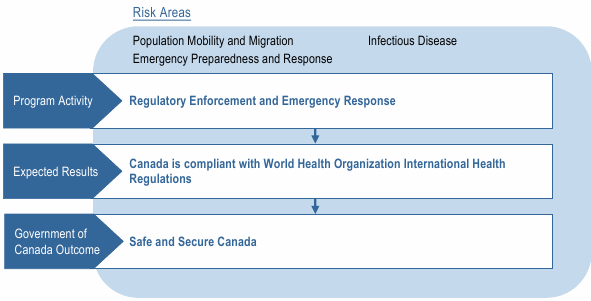
[enlarge]
Program Activity Description
Several significant public health events such as SARS (Severe Acute Respiratory Syndrome), West Nile virus, Listeria, and avian and pandemic influenza show that infectious disease outbreaks and agents continue to threaten public health. This program protects the health of Canadians by contributing to the development, implementation and enforcement of legislation and regulations to control the use and containment of pathogens and toxins in addition to quarantine services for travelers entering and departing from Canada; and rapid public health emergency response infrastructure such as human resource surge capacity, 24/7 communication and situational awareness services, and mobile laboratory services capable of processing high-risk pathogens. The program also consists of emergency medical supplies, and equipment located across Canada to support response to public health emergencies. This combination of regulation, rapid response capacity and on-demand emergency supplies provides public health authorities in Canada other federal government departments and agencies, international health authorities, Canadian health professionals, and members of the public with the tools, information, and resources required to help mitigate the threat of infectious disease.
Human Resource (FTEs) and Planned Spending ($ M)
| 2012–13 | 2013–14 | 2014–15 | |||
|---|---|---|---|---|---|
| FTEs | Planned Spending |
FTEs | Planned Spending |
FTEs | Planned Spending |
| 146 | 24.0 | 146 | 24.0 | 147 | 24.1 |
| Expected Result(s) | Performance Indicator(s) | Target(s) |
|---|---|---|
| Canada is compliant with World Health Organization (WHO) International Health Regulations (IHR) | % of Agency procedures which are compliant with WHO IHR | 100% |
Planning Highlights
Supporting national readiness for prevention of and effective response to public health threats and enabling the development, implementation and enforcement of legislation related to the use and containment of pathogens and toxins contribute significantly to the mix of tools, information and resources required to mitigate threats to public health. The following major activities are planned:
- Continue the design and development of a risk-based program and regulatory framework for the Human Pathogens and Toxins Act that is informed through broad stakeholder consultations.
- Enhance service delivery and responsiveness to reduce the administrative burden encountered by regulated parties involved in the import, storage and manipulation of human/animal pathogens and regulated toxins.
- In the context of the Canada-US Beyond the Borders Action Plan, reduce the impacts of shared health security risks through expanded bilateral collaboration that advances North American biosecurity and pathogen control, and enhanced interoperability of emergency management and response systems.
- Facilitate inter-jurisdictional sharing of health professionals during a public health event via a revised emergency response surge capacity model/framework.
- Clarify federal, provincial, territorial and local roles and responsibilities with regard to quarantine activity via the development of a national framework.
- Designate Yellow Fever Vaccination centres in compliance with IHR requirement and facilitate entry of Canadian travellers where country entry requirements for yellow fever vaccination exist.
- Continue to modernize the National Emergency Stockpile System with the implementation of strategic, operational and disposal plans and an automated inventory system as well as the streamlining of assets through risk-informed evidence-based decisions.
- Enhance internal Agency business continuity planning capacity to address an "all hazards" approach so the Agency has the ability to maintain critical services to fulfill its mandate to Canadians at all times.
Program Activity 2.1 – Internal Services
Program Activity Description
Internal services support the Agency's strategic outcome and all six PA's. Internal services are groups of related activities and resources that are administered to support the needs of programs and other corporate obligations of an organization. These groups are Management and Oversight Services, Communications Services, Legal Services, Human Resources Management Services, Financial Management Services, Information Management Services, Information Technology Services, Real Property Services, Materiel Services, Acquisition Services, and Travel and Other Administrative Services. Internal services include only those activities and resources that apply across the Agency and not those provided specifically to a program.
Human Resource (FTEs) and Planned Spending ($ M)
| 2012–13 | 2013–14 | 2014–15 | |||
|---|---|---|---|---|---|
| FTEs | Planned Spending |
FTEs | Planned Spending |
FTEs | Planned Spending |
| 675 | 95.4 | 675 | 95.3 | 677 | 95.2 |
| Expected Result(s) | Performance Indicator(s) | Target(s) |
|---|---|---|
| The communications, service operations and programs of the Agency comply with applicable laws, regulations, policies and plans and meet the diverse needs of the public | Compliance with the Government of Canada Communications Policy | 100% |
| Compliance with the statutory time requirements of the Access to Information Act and Privacy Act (ATIP) | Achieve an Office of the Information Commissioners Rating "A" Rating (95%) | |
| Compliance with the Government of Canada Official Languages Act, Part IV, Communications with and services to the public | 100% | |
| Strategic allocation and prudent use of resources among programs, processes and services | % Year-end Agency variance of planned versus actual expenditures | 5 % variance or less |
| Compliance with the Government of Canada Employment Equity Act |
Achieve a work force representative of work force availability estimates based on the 2006 Census by March 31, 2013 Aboriginal People – 3.1% Persons with Disabilities – 4.3% Visible Minorities – exceed 13.1% Women – 61.8% |
|
| Assets are acquired and managed in a sustainable and financially responsible manner throughout the lifecycle | % of compliance with legislation, regulations, policies, standards and best practices | 100% |
Planning Highlights
Sound resource management and improved knowledge translation, information management and science-based decision-making systems facilitate access to the latest public health information for all Canadians. The same also enables improvements in the efficiency and effectiveness of PHAC's operations. The following major activities are planned:
- Maintain the engagement of employees and positive messaging related to Public Service Renewal within the current context of fiscal restraint.
- Ensure that issues identified by PHAC employees in the 2011 Public Service Employee Service are addressed in Agency action plans.
- Adopt and implement an Agency-specific values and ethics code that promotes and supports integrity-driven organizational practices, a corporate culture that espouses values and ethics, and employee engagement.
- Continue development and implementation of a phased approach to talent management for executives, feeder groups and public health professionals.
- Support the Federal Sustainable Development Strategy through the implementation of the PHAC 2011-2014 Departmental Sustainable Development Strategy. Key commitments relating to green buildings, surplus electronic and electrical equipment, printing units, and green procurement are identified in the Greening Government Operations supplementary information table.
- Enhance integrated security services in compliance with the Policy on Government Security by performing certification and accreditation of mission-critical applications and/or systems, implementing the Departmental Security Plan, and completing the Threat and Risk Assessments to safeguard the Agency's intellectual property and asset resources.
- Enhance occupational health and safety services in compliance with Part II of the Canada Labour Code and the Canada Occupational Health and Safety Regulations by developing and promoting Agency policies and procedures thereby ensuring a uniform approach to occupational health and safety.
Federal Sustainable Development Strategy
![]() The Public Health Agency of Canada is a participant in the Federal Sustainable Development Strategy (FSDS) and contributes to the Greening Government Operations targets through the internal
services PA. The department contributes to the following target areas of Theme IV of the FSDS:
The Public Health Agency of Canada is a participant in the Federal Sustainable Development Strategy (FSDS) and contributes to the Greening Government Operations targets through the internal
services PA. The department contributes to the following target areas of Theme IV of the FSDS:
- Green Buildings
- Surplus Electronic and Electrical Equipment
- Printing Unit Reduction
- Paper Consumption
- Green Meetings
- Green Procurement
For additional details on Public Health Agency's Greening Government Operations (GGO) activities please view the Agency's GGO Tables.
